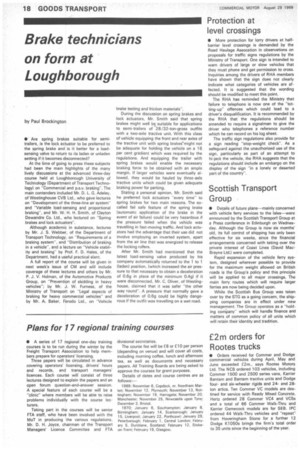Brake technicians on form at Loughborough
Page 20

If you've noticed an error in this article please click here to report it so we can fix it.
by Paul Brockington IV Are spring brakes suitable for semitrailers, is the lock actuator to be preferred to the spring brake and is it better for a loadsensing valve to return to its laden or unladen setting if it becomes disconnected?
At the time of going to press these subjects had been the main highlights of the many lively discussions at the advanced three-day course held at Loughborough University of Technology (Department of Transport Technology) on "Commercial and p.s.v. braking". The main contenders included Mr. D. L. G. Adeley, of Westinghouse CVB Ltd., who gave lectures on "Development of the three-line air system" and "Variable load-sensing and proportional braking", and Mr. W. H. H. Smith, of Clayton Dewandre Co. Ltd., who lectured on "Spring brakes and lock actuators".
Although academic in substance, lectures by Mr. J. S. Webber, of the Department of Transport Technology, on "Requirements of a braking system", and "Distribution of braking in a vehicle", and a lecture on "Vehicle stability and braking" by Prof. F. D. Hales, of the Department, had a useful practical slant.
A full report of the course will be given in next week's issue of CM and will include coverage of these lectures and others by Mr. P. J. V. Holman, of the Automotive Products Group, on "Prevention of skidding in heavy vehicles"; by Mr. J. W. Furness, of the Ministry of Transport on "Legal aspects of braking for heavy commercial vehicles" and by Mr. A. Baker, Ferodo Ltd., on 'Vehicle brake testing and friction materials".
During the discussion on spring brakes and lock actuators, Mr. Smith said that spring brakes might well be suitable for applications to semi-trailers of 28 /32-ton-gross outfits with a two-axle tractive unit. With this class of vehicle equipping the front and rear axles of the tractive unit with spring brakes"might not be adequate for holding the vehicle on a 16 per cent gradient which was required by the regulations. And equipping the trailer with spring brakes would enable the necessary braking force to be obtained with an ample margin. If larger vehicles were eventually allowed, they would be hauled by three-axle tractive units which could be given adequate braking power for parking.
Stating a personal opinion, Mr. Smith said he preferred lock actuators -every time" to spring brakes for two main reasons. The socalled fail safe feature of the spring brake (automatic application of the brake in the event of air failure) could be very hazardous if the pressure failed when the vehicle was travelling in fast-moving traffic. And lock actuators had the advantage that their use did not involve employing an inverted system, apart from the air line that was energized to release the locking rollers.
After Mr. Smith had mentioned that the latest load-sensing valve produced by his company automatically returned to the 1 to 1 (laden) position, (which increased the air pressure to that necessary to obtain a deceleration of 0.6g in place of the minimum 0.4g) if it were disconnected, Mr. C. Oliver, of Westinghouse, claimed that it was safer "the other way round". A pressure that normally gave a deceleration of 0.69 could be highly dangerous if the outfit was travelling on a wet road.




































































































